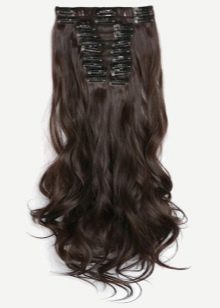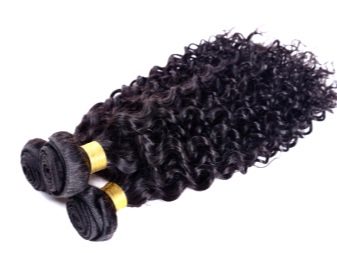Wavy curls, of course, look very unusual and attractive. To get provocative curls, women of fashion curl their hair with forceps and perms. At the same time, the owners of naturally curly hair know how difficult it is to grow them to a length below the shoulder blades. Many people are interested in what to do for those who want to have a luxurious “lion's mane” without special difficulties and time costs. You can use curly hair extension services.

Characteristic
The procedure for building curly curls is not too different from the procedure for building straight hair. However, there is a difference, it is visible in the following nuances:
- it is very difficult to find donor locks that would curl from nature, therefore, they often resort to artificial perm;
- it is more difficult to care for such hair, since when it grows back, it begins to become tangled and form tangles;
- due to the use of chemical components for curling donor curls, they become stiff, combing them can be problematic.
Important! If you are the owner of straight hair, then you do not “shine” building curly. It is quite possible, but first you have to cut your hair so that the difference in structure is not striking.
Depending on the origin, there are such types of donor strands as:
- asian - Curls originally from Asia (mainly from China) are notable for their low price, but rather average quality;
- European - locks from Europe take the second place;
- Slavic - They are considered the best because they have a longer wear period and are better to curl.



Methodologies
They try to carry out curly hair extensions using more gentle methods than they do with straight ones. Let's figure out which extension technologies exist today, which one is most recommended for curly curls.
- African. Its essence lies in weaving a braid-basket from natural hair and circular sewing of tresses to it. When the extension ends, the tresses are sure to cut, forming a hairstyle. Such a procedure has such advantages as the absence of temperature effects, low price, ease in combing the accumulated tresses. But there are also disadvantages: it will not be possible to braid hair in braids, such as "French", the fastening points of tresses are visible, and it is also difficult to wash your hair.
- Tape extension. With this method of attachment, donor strands are formed into tapes with an adhesive applied to them. This technology does not harm the hair, is carried out quite quickly and is suitable for very curly curls. But it has drawbacks: correction is often required, and the price is quite high.
- Italian Its essence lies in the fact that donor strands are formed by connecting the hairs into bundles and fastening them with microcapsules from keratin. When building such a capsule is “soldered” to the roots of the hair. The advantages are that the attachment points are almost invisible, which allows you to experiment with hairstyles, donor locks have an ideal waviness and fully fit into natural hair, with proper care, the wearing time can reach six months. It was not without drawbacks, the price refers to them, because it is much higher than average, the extension procedure lasts a very long time (6-7 hours), and the capsules are felt in the hair when in bed, so they can cause discomfort during sleep.


- English This technology is similar to the previous one, but with the only difference being that special keratin is applied to the base of the donor strands. The advantages of this technique are its low price, capsules are not felt in the hair, this technology is suitable for almost any type of hair, and the hair has a natural look. If we consider the shortcomings, it is worth noting that this option is not suitable for rare hair, it takes a long time, when using a hairdryer, the capsules may break and the locks will disappear.
- Spanish. The specialist manually forms an adhesive capsule from surgical glue and applies it to the base of the donor strand. Capsules can be both large and small - this is decided by the master. Curls are attached to natural hair without any temperature effect. The Spanish method is considered optimal for building curly hair. Its advantages are obvious and are as follows: it does not harm natural hair, the adhesive structure is not susceptible to thermal effects (curls can be dried with a hairdryer), you can even swim in the sea with such hair. But there are also disadvantages: such a build-up is expensive, it is not recommended to use masks and conditioners when washing your hair.



Wearing time
Of course, the duration of wearing the built-in curls will depend on the correctness of the care procedures and building technology.
For example, the African method assumes a sock period of not more than 3 months, while English will allow you to enjoy the extended curls of 6-8 months.
However, these are average indicators with which your personal characteristics may not coincide, for example, hair growth rate. Therefore, experts recommend that corrective procedures be performed at least every 2-3 months, which will help you maintain an attractive and healthy appearance of your hair.


Contraindications
Unfortunately, not every girl can grow hair. There are the following contraindications that can not be ignored so as not to harm health:
- if you are taking antibiotics or hormones, refuse hair extensions for this period;
- in the presence of a tendency to migraine headaches, VVD or if there is an oncological disease, it is forbidden to build curls;
- if there is a tendency to alopecia, hair loss, it is better to treat hair at first.


Advantages and disadvantages
The growth of wavy curls has the following advantages:
- beauty and aesthetics - many people have curly hair, and besides, they add a touch of mischief and protest to the image;
- donor curls can be attached not only to naturally curly hair - they can also be extended to short straight curls, in a matter of hours your bow will change beyond recognition;
- curls give room for imagination - they look elegant, with them you can do everyday and holiday hairstyles;
- in curly hair, the attachment points of donor strands are not as noticeable as in straight ones.
It is worth noting such disadvantages as:
- the cost of building curls is higher than building smooth curls, since such strands require additional chemical treatment to fix curls;
- care procedures with such hair are more difficult to carry out than with straight ones;
- not all masters are able to work with curly curls, but you should not be shy to clarify this point, look at the specialist’s portfolio, note the presence / absence of such works in it, because if the master-inept works poorly, you risk your natural hair.



Care Tips
You went through the procedure of building curls and now on your head gorgeous curls flaunt. It is worth taking into account the following tips for maintaining extended hair for a longer period:
- wash your head while standing upright in the shower; use only specialized products recommended by the hairdresser;
- never go to bed with wet curls, this is not only about going to bed - even if you simply lie on the pillow without drying the hair, you risk spoiling its shape and getting a “nest” on your head;
- use tools to facilitate combing hair - masks, balms - but do not apply them to the roots, only 1/3 of the total length;
When using the dryer for drying, choose a cool mode.


Other recommendations for caring for hair extensions are given in the video below.










